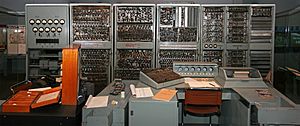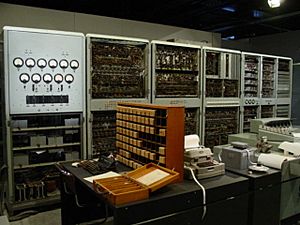CSIRAC facts for kids

CSIRAC, Australia's first digital computer, as displayed at the Melbourne Museum
|
|
| Also known as | CSIR Mk 1 |
|---|---|
| Type | Digital computer |
| Release date | c.1949 |
| Units shipped | 1 |
CSIRAC (which stands for Commonwealth Scientific and Industrial Research Automatic Computer) was first called CSIR Mk 1. It was Australia's very first digital computer. It was also the fifth stored program computer ever built in the world.
CSIRAC is the oldest working electronic computer from its time. (The Zuse Z4 is older, but it used mechanical parts, not electronics). CSIRAC was also the first computer in the world to play digital music!
After being shown at Melbourne Museum for many years, CSIRAC moved to Scienceworks in 2018. You can see it there today in the Think Ahead gallery.
Contents
How CSIRAC Was Made
CSIRAC was built by a team led by Trevor Pearcey and Maston Beard. They worked on it mostly by themselves. This was separate from similar projects happening in Europe and the United States.
First Steps
The computer ran its very first test program in November 1949. This program simply multiplied numbers. CSIRAC started working in a limited way in late 1950. It was shown to the public and fully working in 1951.
How CSIRAC Worked
CSIRAC was a typical computer from its early days. It used valves (like old light bulbs) to work.
Memory and Speed
- Main Memory: CSIRAC used special "mercury acoustic delay lines" to store information. Think of it like sound waves traveling through mercury to hold data. It could store 768 "words" (pieces of data), and later this was doubled.
- Extra Storage: It also had a "disk-type device" for more storage. This could hold 1024 words.
- Speed: The computer's internal clock ran at 1000 Hz. This means it did 1000 cycles per second. It took two cycles to do one instruction at first, but later it became faster, doing one instruction per cycle.
- Data Flow: The way data moved inside the computer was "serial". This means it sent one bit of information at a time, like cars going one by one on a narrow road.
Parts Inside
CSIRAC had about 2000 valves. Some common types were 6SN7 and 6V6. Later, some parts were updated to use germanium transistors. Transistors were a newer, smaller technology.
Getting Information In and Out
- Input: You put information into CSIRAC using punched paper tape. This was a long strip of paper with holes punched in it to represent data. They tried using punch cards first, but they didn't work as well.
- Control: The machine had a control console. This allowed people to run programs step-by-step. It also had CRT screens (like old TV screens) to show what was happening inside the computer.
- Output: Results came out on a standard teleprinter (like an old typewriter that could print messages from the computer) or onto more punch tape.
Computer Language
CSIRAC had a basic set of instructions it could understand. These instructions helped it do math and logic tasks. It could also jump to different parts of a program.
- Instructions: Each instruction had three parts: a "destination," a "source," and an "address." These parts told the computer where to get data, what to do with it, and where to put the result.
- No Operating System: Unlike computers today, CSIRAC didn't have an operating system (like Windows or macOS).
- INTERPROGRAM: In 1960, a special programming language called INTERPROGRAM was created for CSIRAC by Geoff Hill. It was similar to early versions of BASIC.
Playing Music
In 1950, CSIRAC was used to play music. This was the first time a digital computer was used for this! The original music wasn't recorded, but it has been recreated accurately.
In 1955, the CSIRO decided that computer research wasn't their main focus. So, CSIRAC was moved from Sydney to the University of Melbourne. It became Australia's only academic computer facility until late 1956. Many early computer users in Australia learned about computing there.
Keeping CSIRAC Safe
In 1964, CSIRAC was turned off for the last time. People already knew it was very important for history. So, it was put into storage with plans to show it in a museum later.
Its Journey
- CSIRAC was stored in a warehouse through the 1960s and 1970s.
- From 1980 to 1992, it was shown at the Caulfield Institute of Technology (which later became part of Monash University).
- After that, it went back into storage.
Renewed Interest
In the 1990s, people became interested in CSIRAC again. They realized that many of the people who built it were getting older, and important history could be lost. A conference about the machine was held in 1996.
Permanent Home
In 2000, CSIRAC found a permanent home with Museums Victoria. It hasn't worked since it was shut down. However, many of the programs that ran on it have been saved. An emulator (a program that acts like CSIRAC) has also been written.
The museum decided not to make CSIRAC work again. It would cost a lot of money and need many repairs to be safe. CSIRAC used 30 kilowatts of power when it was running! Also, fixing it up too much might make it less historically real.
As mentioned earlier, after being at Melbourne Museum for many years, it moved to Scienceworks in 2018. It is now on permanent display in the Think Ahead gallery.
Historical Recognition
CSIRAC is listed on the Victorian Heritage Register. This means it's recognized as an important historical item in Victoria, Australia. It is also listed as a National Engineering Landmark by Engineers Australia.
See also
 In Spanish: CSIRAC para niños
In Spanish: CSIRAC para niños


